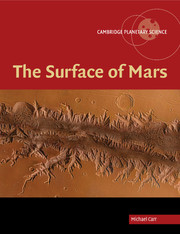14 - Summary
Published online by Cambridge University Press: 12 August 2009
Summary
From the discussion in the previous chapters we can reconstruct the broad outlines of the geological history of the planet. The history that is potentially decipherable from the surface morphology has been divided into three eras: the Noachian, which extends from roughly 4.1 Gyr ago to 3.7 Gyr ago, the Hesperian from roughly 3.7 to 3 Gyr ago, and the Amazonian from 3 Gyr ago to the present. The era prior to the Noachian has not been formally named because the geological record for that era has been largely erased. Arguably the most important era of the planet's history was the first 800 million years. When Mars emerged from the Noachian around 3.7 Gyr ago it was on an evolutionary path very different from that of the Earth and the other terrestrial planets. Its geology had a distinctively martian style that was sustained for the rest of the planet's history.
Mars accreted and differentiated to form a core remarkably quickly. The core formed within 20 Myr of the age of the formation of the Ca–Al-rich inclusions in carbonaceous chondrites, which, with an age of 4.567 Gyr, are the oldest objects in the Solar System (Chapter 4). It had formed before creation of the Earth's Moon, which is regarded as the terminal event in the formation of the Earth and dated at 30–50 Myr after the formation of the Solar System. Core formation probably released enough energy to leave the core liquid and convecting, thereby creating a magnetic field around 4.5 Gyr ago.
- Type
- Chapter
- Information
- The Surface of Mars , pp. 277 - 282Publisher: Cambridge University PressPrint publication year: 2007



